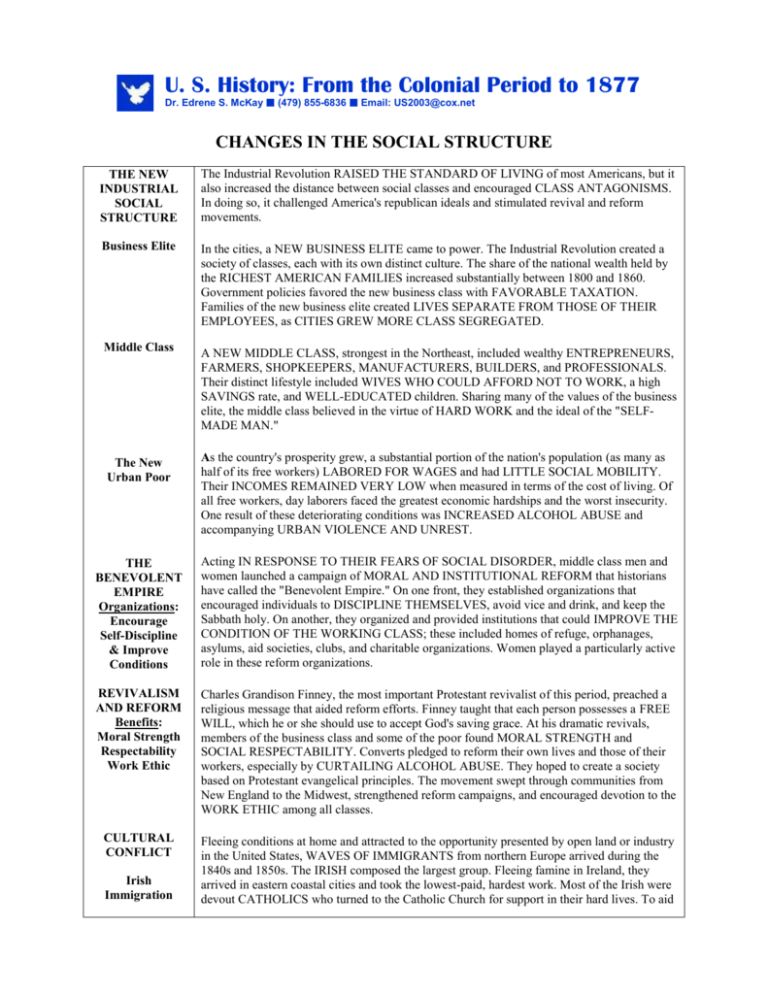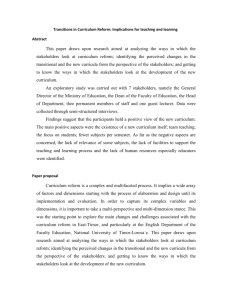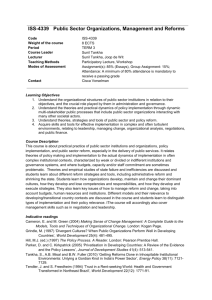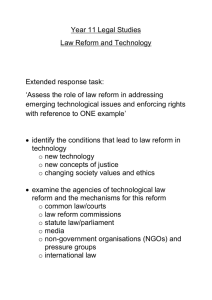Changes in the Social Structure - Online
advertisement

U. S. History: From the Colonial Period to 1877 Dr. Edrene S. McKay (479) 855-6836 Email: US2003@cox.net CHANGES IN THE SOCIAL STRUCTURE THE NEW INDUSTRIAL SOCIAL STRUCTURE The Industrial Revolution RAISED THE STANDARD OF LIVING of most Americans, but it also increased the distance between social classes and encouraged CLASS ANTAGONISMS. In doing so, it challenged America's republican ideals and stimulated revival and reform movements. Business Elite In the cities, a NEW BUSINESS ELITE came to power. The Industrial Revolution created a society of classes, each with its own distinct culture. The share of the national wealth held by the RICHEST AMERICAN FAMILIES increased substantially between 1800 and 1860. Government policies favored the new business class with FAVORABLE TAXATION. Families of the new business elite created LIVES SEPARATE FROM THOSE OF THEIR EMPLOYEES, as CITIES GREW MORE CLASS SEGREGATED. Middle Class A NEW MIDDLE CLASS, strongest in the Northeast, included wealthy ENTREPRENEURS, FARMERS, SHOPKEEPERS, MANUFACTURERS, BUILDERS, and PROFESSIONALS. Their distinct lifestyle included WIVES WHO COULD AFFORD NOT TO WORK, a high SAVINGS rate, and WELL-EDUCATED children. Sharing many of the values of the business elite, the middle class believed in the virtue of HARD WORK and the ideal of the "SELFMADE MAN." The New Urban Poor As the country's prosperity grew, a substantial portion of the nation's population (as many as half of its free workers) LABORED FOR WAGES and had LITTLE SOCIAL MOBILITY. Their INCOMES REMAINED VERY LOW when measured in terms of the cost of living. Of all free workers, day laborers faced the greatest economic hardships and the worst insecurity. One result of these deteriorating conditions was INCREASED ALCOHOL ABUSE and accompanying URBAN VIOLENCE AND UNREST. THE BENEVOLENT EMPIRE Organizations: Encourage Self-Discipline & Improve Conditions Acting IN RESPONSE TO THEIR FEARS OF SOCIAL DISORDER, middle class men and women launched a campaign of MORAL AND INSTITUTIONAL REFORM that historians have called the "Benevolent Empire." On one front, they established organizations that encouraged individuals to DISCIPLINE THEMSELVES, avoid vice and drink, and keep the Sabbath holy. On another, they organized and provided institutions that could IMPROVE THE CONDITION OF THE WORKING CLASS; these included homes of refuge, orphanages, asylums, aid societies, clubs, and charitable organizations. Women played a particularly active role in these reform organizations. REVIVALISM AND REFORM Benefits: Moral Strength Respectability Work Ethic Charles Grandison Finney, the most important Protestant revivalist of this period, preached a religious message that aided reform efforts. Finney taught that each person possesses a FREE WILL, which he or she should use to accept God's saving grace. At his dramatic revivals, members of the business class and some of the poor found MORAL STRENGTH and SOCIAL RESPECTABILITY. Converts pledged to reform their own lives and those of their workers, especially by CURTAILING ALCOHOL ABUSE. They hoped to create a society based on Protestant evangelical principles. The movement swept through communities from New England to the Midwest, strengthened reform campaigns, and encouraged devotion to the WORK ETHIC among all classes. CULTURAL CONFLICT Fleeing conditions at home and attracted to the opportunity presented by open land or industry in the United States, WAVES OF IMMIGRANTS from northern Europe arrived during the 1840s and 1850s. The IRISH composed the largest group. Fleeing famine in Ireland, they arrived in eastern coastal cities and took the lowest-paid, hardest work. Most of the Irish were devout CATHOLICS who turned to the Catholic Church for support in their hard lives. To aid Irish Immigration Changes in the Social Structure Catholic Church Growth Nativist Sentiment DISCUSSION QUESTIONS Page 2 its Irish parishioners, the church helped build an institutional network of CHURCHES, SOCIETIES, SCHOOLS, and ORGANIZATIONS that preserved Irish culture. The rising tide of immigration and the growth of the Catholic Church touched off A WAVE OF ANTICATHOLIC SENTIMENT, NATIVIST ORGANIZATIONS, RIOTS, AND VIOLENCE. Class and ethnic differences threatened to divide northern society, even as the majority of white Americans held fast to the shared values of individualism, capitalism, and democratic republicanism. How do you explain the paradox that the industrial revolution raised the standard of living but at the same time stimulated class antagonisms? Has the information age brought us a similar paradox? Explain. How are moral and institutional reform related to revivalism and cultural conflict? How do you account for nativist sentiment during this period?









